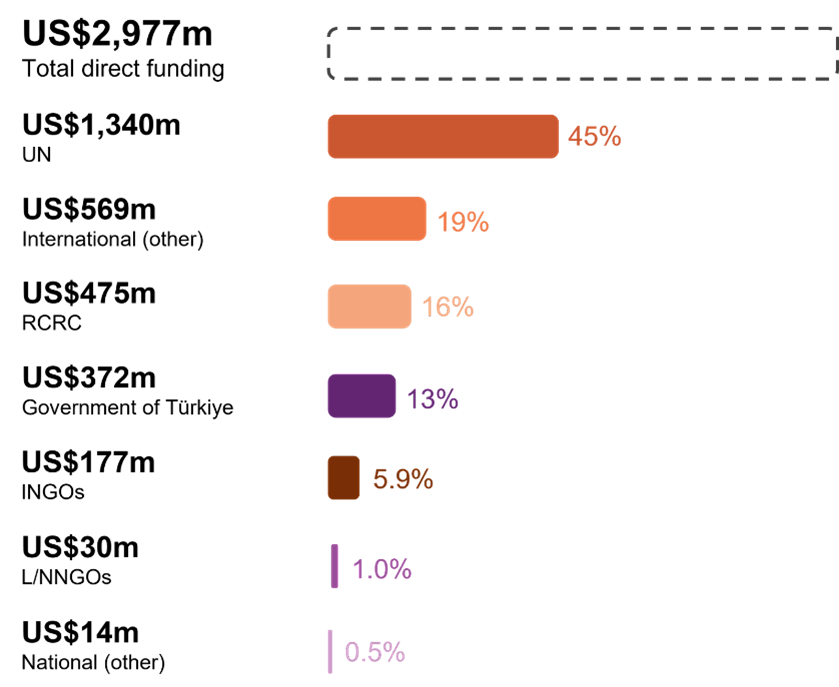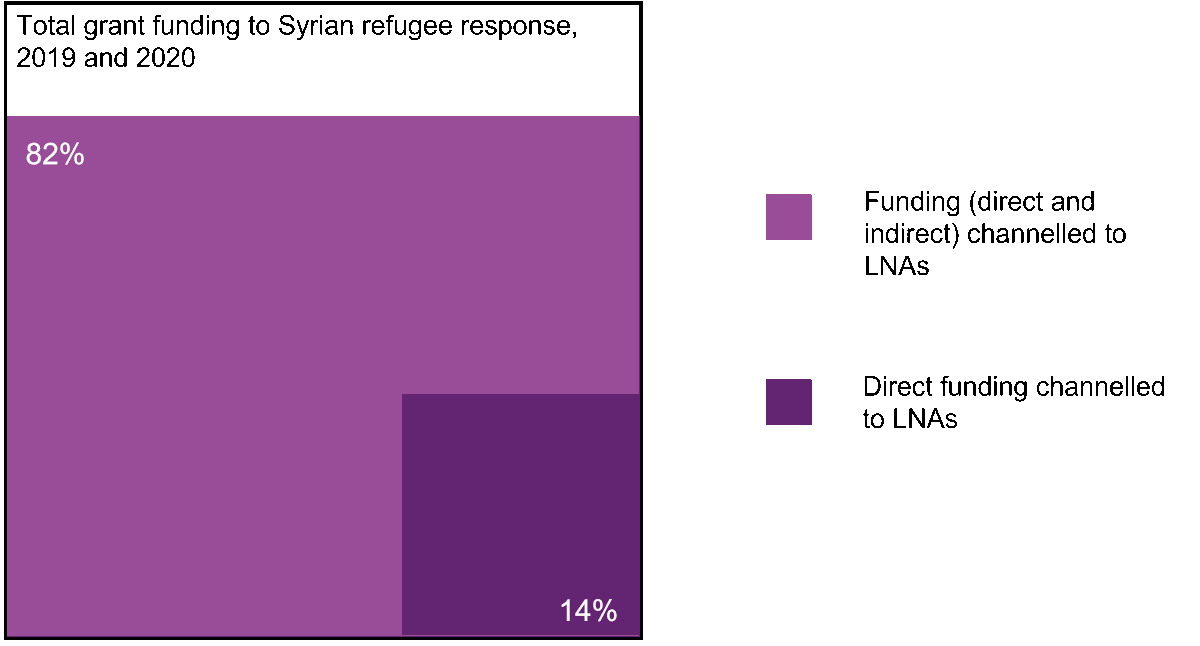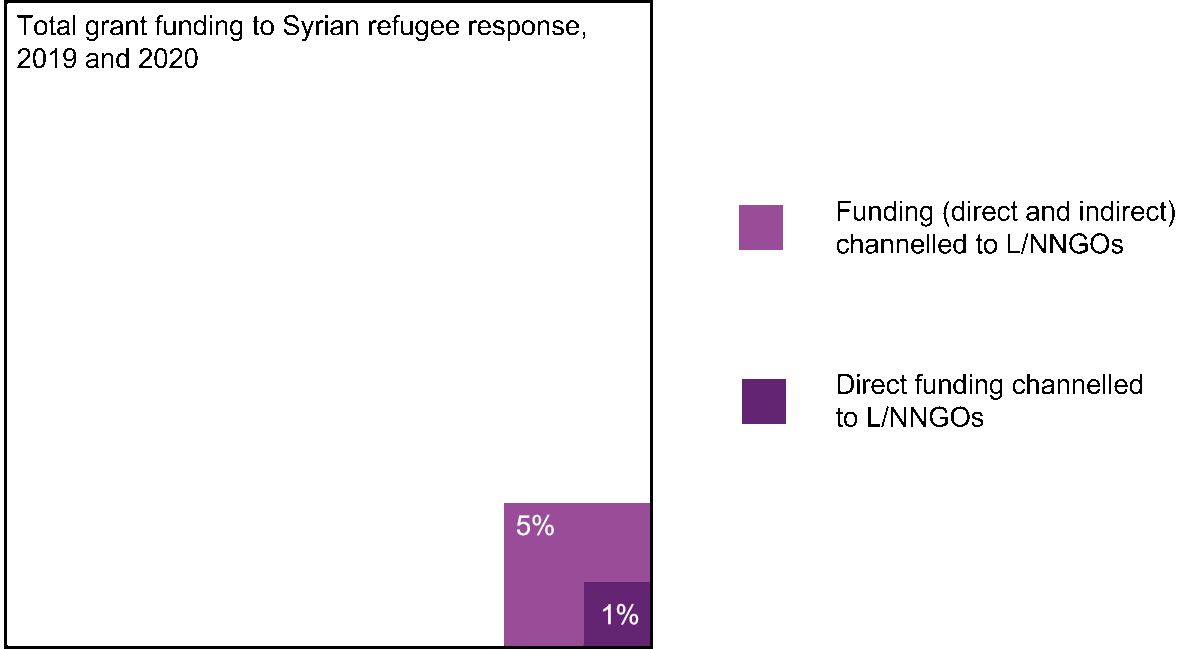Funding to local actors: evidence from the Syrian refugee response in Türkiye: Executive summary
Executive summary
DownloadsOver 11 years after the start of the Syria crisis, Türkiye is host to 3.7 million Syrian women, men, and children. Local and national actors (LNAs), including the government and civil society, play a central role in meeting the needs of displaced communities, with support from international donors and organisations.
Ensuring LNAs have access to sufficient, quality funding as directly as possible is essential for an effective and locally led response. Donors and international aid organisations have made various commitments to provide funding more directly to those affected by crisis. However, current reporting mechanisms mean there is no way to comprehensively monitor these commitments, to track how much international funding ultimately reaches LNAs or the means by which it is disbursed.
This research, carried out by Development Initiatives and the Refugee Council of Türkiye , sought to fill this evidence gap in the context of the Syrian refugee response in Türkiye by tracking international funding flows to local and national actors. It also investigated issues around the quality of funding and partnerships between international and national actors – central to discussions on the localisation of aid in Türkiye and more broadly.
Key findings
1. Most grant funding for the Syrian refugee response in Türkiye was provided directly to international actors in 2019 and 2020

lorem ipsum
Refer to report Figure 8 for source and notes. International (other) includes international financial institutions. RCRC refers to the International Red Cross and Red Crescent Movement.
- The majority of international funding for the Syrian refugee response was provided directly to international organisations. In total, 86% of funding in 2019 and 2020 was provided by donors to international actors, with nearly half being channelled to the UN, followed by other international actors such as international financial institutions and the International Red Cross and Red Crescent Movement (RCRC).
- International donors have provided significant volumes of funding in support of the Syrian refugee response in Türkiye. Our research identified US$3.0 billion of humanitarian and development grant funding in 2019 and 2020. The largest donor was the EU, which saw a significant increase in support to Türkiye in 2016 in return for efforts to limit irregular migration to Europe.
- Direct funding to LNAs was minimal. In total, 14% of total funding in 2019 and 2020 went to LNAs directly, nearly all of which was channelled to the Government of Türkiye (GoT). By contrast, only 1% of funding across the two years was directly provided to local/national non-governmental organisations (L/NNGOs).
- While LNAs received only a small proportion of total funding directly from donors, they are responsible for implementing the majority of response programming. Our research found that of the US$3.0 billion of international funding provided in 2019 and 2020, 82% was ultimately channelled to LNAs – with most passing first through an intermediary.
- L/NNGOs face particular challenges in accessing international funding, especially organisations that are local, refugee-led or women’s organisations. Of total funding received directly and indirectly across both years, on average 5.3% was channelled to L/NNGOs (compared to 10% to INGOs) with tiny fractions reaching refugee-led or women’s organisations (less than 0.2%). Regulations and eligibility requirements exclude many L/NNGOs from directly applying for funding. In turn, donors often do not have the capacity to directly manage grants with local actors and rely on a smaller number of international organisations to manage their contributions. This limits the opportunities L/NNGOs have to influence donor funding priorities.
- Most of the funding which reaches LNAs for the Syrian refugee response was humanitarian. In 2020, 48% of international funding provided by donors was humanitarian, however of the funding passed on by intermediaries, 77% was humanitarian. L/NNGOs were only able to access humanitarian funding. Despite this, the overall proportion of international funding for the Syrian refugee response provided as development funding would seem to be growing as the response becomes more protracted. As donors increase development funding and more funding is channelled to the GoT through international financial institutions (IFIs), there is a risk that funding channels available to L/NNGOs will narrow even further.
- This dependence on funding channelled through humanitarian funding instruments affects the quality of funding accessed by L/NNGOs. L/NNGOs and international organisations interviewed struggle with short-term, tightly earmarked funding, often poorly suited to the type of longer-term resilience building programming being delivered. L/NNGOs are also unable to consistently access overhead funding and this, coupled with short-term funding, affects the sustainability of local organisations, as well as overall programme effectiveness.
- This study found examples of increasingly strategic partnerships between national and international organisations, however barriers remain. The current funding model – as well as entrenched ways of working and power dynamics – reinforced the experience for some L/NNGOs of being ‘sub-contracted’ by international organisations. While partnerships with international organisations have undoubtedly supported the institutional development of L/NNGOs, partly through expanding networks and funding opportunities, there remains a disconnect between global organisational commitments to ‘localisation’ and the reality on the ground. This is further exacerbated by the projectised funding model.
The Turkish context is not unique and many of the challenges faced by LNAs in accessing quality funding are reflected across the humanitarian system. There remains a need to both increase direct, quality funding to LNAs – to increase cost effectiveness and ensure funding decisions are more closely linked to those who know the context and needs best – as well as to further develop strategic partnerships between international and national actors, based on a commitment to equitable and fair partnership principles.

